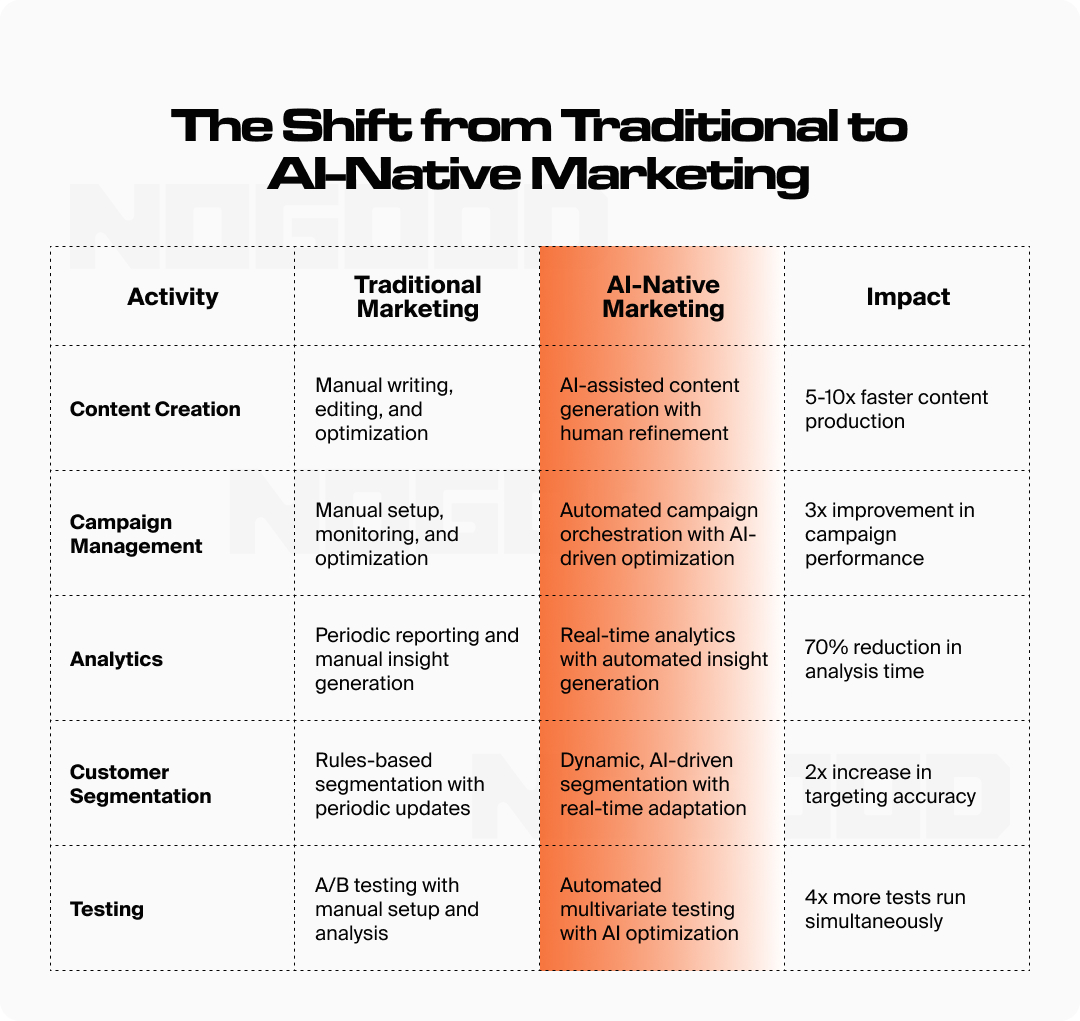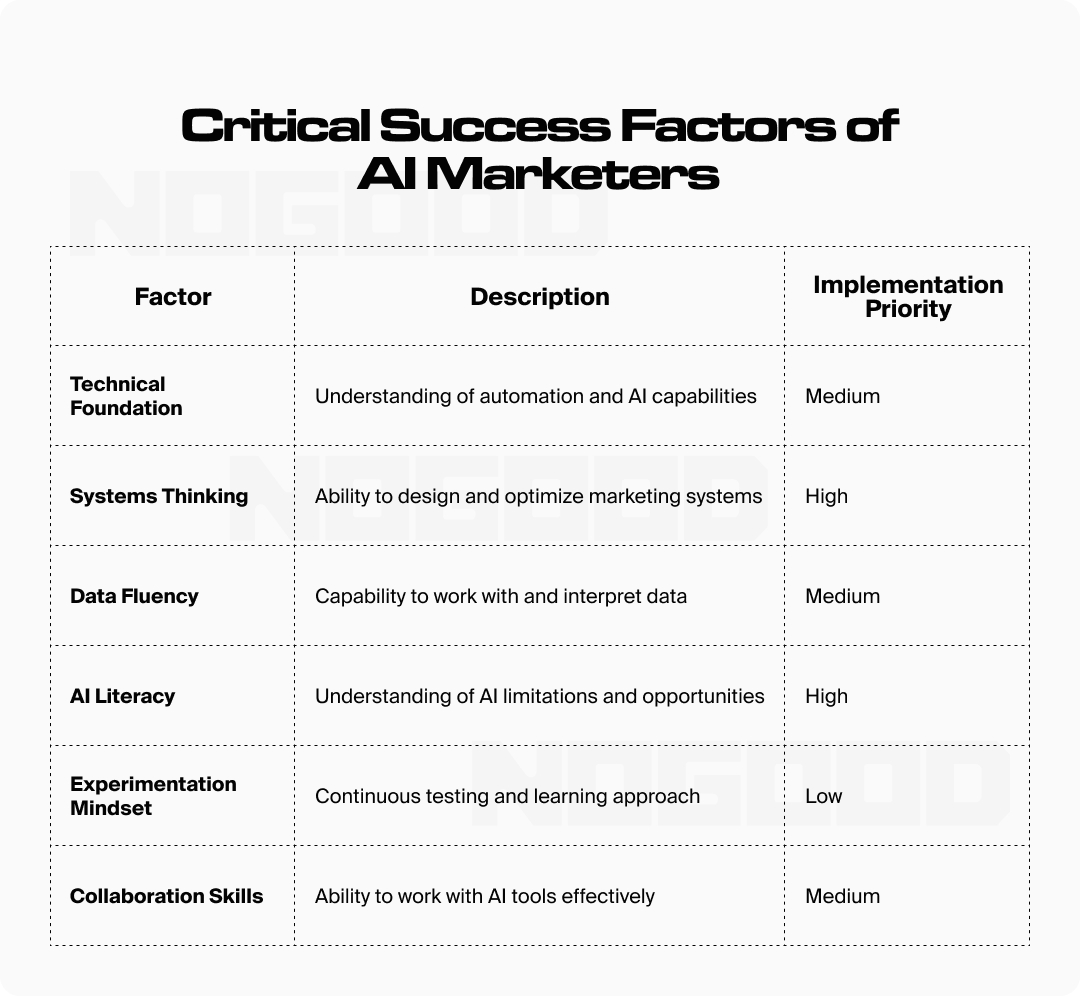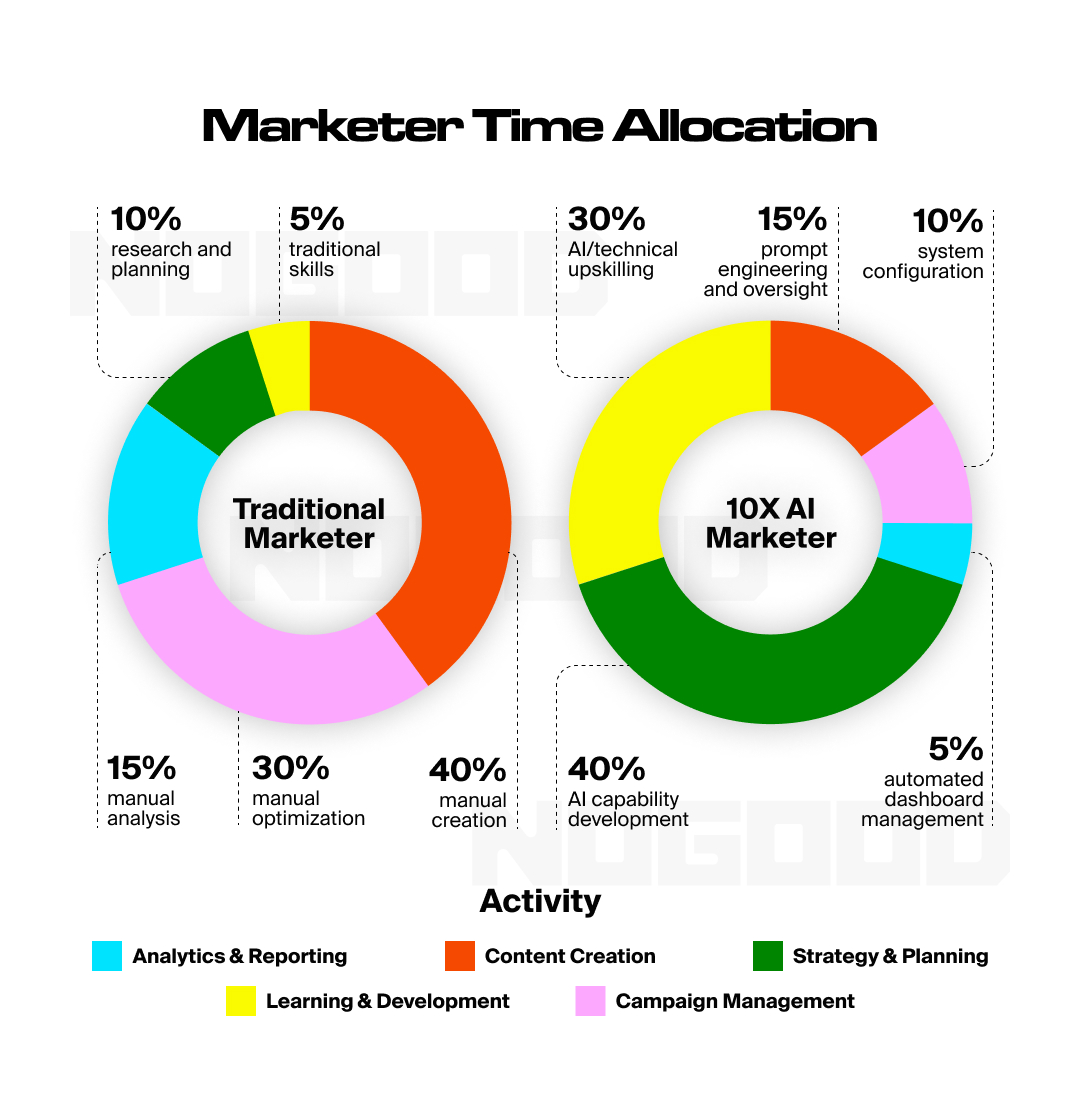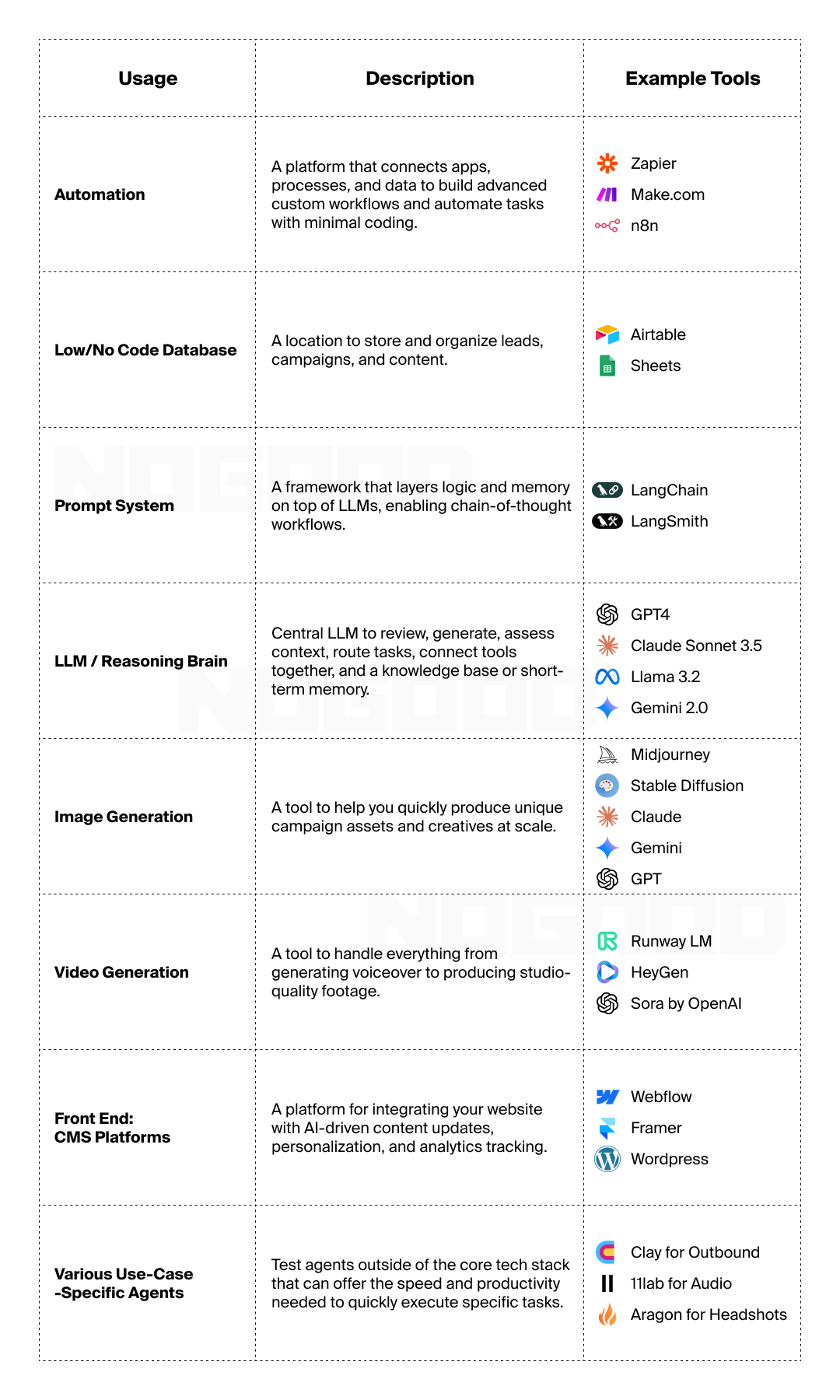AI this, AI that. We get it…
Despite the hype, many marketers’ day-to-day hasn’t changed much from two years ago. We’re still designing, creating content, and spending time analyzing ad platform data, CRMs, and Google Analytics like we always have.
But amidst the AI noise, a new breed of marketer is rapidly emerging.
Introducing the 10X AI Marketer
In engineering, we often hear the term “10X engineer.” It’s usually used to describe a software engineer who is considered significantly more productive than their peers and performs at a level roughly ten times more effective than the average engineer. This concept was rarely applied to marketers. That’s largely because, until now, marketers haven’t had the tools to design and orchestrate large-scale systems the way engineers do.
But I believe this is the time for it.
With the advent and integration of AI, marketers have the chance to become 10X AI marketers, utilizing AI to supercharge and optimize their workflows for better outputs, faster.
In short, 10X AI marketers get 10 times the results in a fraction of the time without doing 10 times the work themselves—AI is doing the heavy lifting. Here’s what makes them stand out:
- They Move Fast. They rapidly prototype ideas, spin up automations, and experiment with novel workflows. AI helps them iterate at lightning speed.
- They Automate Processes. From email campaigns to content creation, they streamline production through AI automations. Mundane manual tasks become automated processes.
- They Master Multi-Tool Ecosystems. They tap into a range of tools—automation platforms, data layers, and LLM APIs—to piece together custom marketing solutions that fit their GTM motion.
- They Deliver Substantial Productivity Output. Their ability to fuse AI with their marketing know-how unlocks a multiplier effect, propelling key metrics and organizational growth.
So, how did we get here?
AI and the Collapse of the Talent Stack
Our work is often defined by our goals and the tools we use to achieve them. For the past two decades, our talent stack and team structures have remained largely unchanged, including how we define roles and the lines between them.
For the most part, someone was considered a “unicorn” if they had skills and capabilities outside of their main area of expertise. Progressing in your field meant specializing, further solidifying the lines between roles and responsibilities.
But as AI capabilities continue to expand, traditional job roles will begin to blur. Product managers will casually code, performance marketers will design their own ads, and designers will step into copywriting—all powered by AI. What was once considered “unicorn” territory will become the new baseline.
In the coming years, it will be critical to think strategically and adapt quickly to emerging tech to thrive.
This shift isn’t limited to marketing; it will impact the entire talent stack. However, marketing functions are likely to be the most affected, as reflected in recent AI job impact reports and studies.
From Individual Contributor to Systems Orchestrator: AI Agents & Changing Team Structures
The classic SaaS martech stack we’ve relied on for so long is evolving as it’s challenged by the promise of AI agents. As these agents come to fruition, they’ll have a substantial impact on both team structures and roles of individual contributors. The role of the AI agent—and how marketers are using them—is going beyond automating tasks to impact how teams operate, scale, and deliver value.
In the past, traditional marketing roles focused on personal output: campaigns managed, content created, or leads generated. The AI-native marketer, however, can utilize AI agents to build and then orchestrate systems that multiply their contributions and impact beyond these simple outputs.
As these roles start to shift, it’s becoming abundantly clear that with the right AI-powered tools, anyone—across levels and functions—can push themselves to new heights as systems designers, managers, and orchestrators.
How This is Unfolding in Performance Marketing: AI-Native Pods
Ad buying is becoming increasingly streamlined as AI automates campaign management. Tasks that once took hours—like setting up campaigns, conducting keyword research, and configuring ad groups—are now faster and easier.
Today’s performance marketers are expanding their roles beyond managing and optimizing campaigns. They’re making creative decisions, producing ads, and setting up analytics and tracking systems.
What was once a unique, “unicorn” skill composition, often found in small teams or at fast-growing startups, is becoming the industry standard going forward. With this shift, we’re seeing silos and boundaries between roles break down and marketers developing AI-powered systems to fuel their workflows.
Content Generation Systems have already replaced individual content creation, with many marketers now designing content frameworks that auto-generate variations for different channels, adapt tone based on audience segments, and optimize based on performance data.
Teams will start to reshape, consolidate, and organize around these functional systems, forming function-oriented pods. A Demand Generation Pod, for example, would combine the capabilities and skill sets of automation engineers, content strategists, and analytics specialists. The Customer Journey Pod would merge product marketing, customer success, and technical integration, while the Brand Experience Pod would unite creative direction, content systems, and engagement automation.
Teams structured this way are true AI-native teams, powered by 10X AI marketers.

The Rise of 10X AI Marketers
Your CEO or founder likely had a bunch of AI initiatives in 2024. The marketer that showed the most curiosity, rushed to be there first, and ran the most experiments is likely your future 10X AI marketer.
Imagine a marketer fluent in AI tools, automation workflows, and data analytics—someone equally comfortable in strategic boardroom discussions and prompt-engineering brainstorms. They’re not intimidated by new, seemingly complex tech; they thrive on it. They run experiments with agents, memory modules, and knowledge bases to push campaigns further, faster.
Instead of treating AI like a mysterious black box or hesitating in the face of this major change, they see it as a partner, an extension of their own marketing expertise, and a way to refine their talents and ensure they stay relevant. Driven by curiosity, they constantly explore fresh applications, workflows, and prompts. Their end goal: drive business growth with measurable, AI-fueled outcomes.
The Core Skill Set of a 10X AI Marketer
- Strong Automation Know-How: These marketers are comfortable with workflow automation platforms like Make.com, N8N, or Zapier for managing data flow and automating anything from lead nurturing to social media scheduling.
- Coding or Rapid Prototyping Skills: Even basic coding literacy can be a massive advantage. Whether it’s tweaking an API or setting up a custom script, these marketers quickly turn ideas into action.
- Data Analytics Background: AI thrives on data, so understanding how to collect, analyze, and interpret it is crucial for guiding smarter decisions and measuring impact.
- Prompt Engineering Foundation: They know how to coax the best outcomes from large language models—whether via zero-shot, few-shot, or chain-of-thought prompting.
- Critical and Strategic Thinking: AI doesn’t replace strategic acumen. It amplifies it. 10X AI Marketers understand the marketing funnel end to end and apply AI where it matters most.
- Copywriting and Empathy: AI can generate text, but it can’t always sense the emotional undercurrents of your audience. Strong human copywriting skills ensure the final message resonates.
- Tech Savvy and Adaptable: With AI evolving daily, a willingness to learn, test, and pivot is essential. 10X AI Marketers are always on the hunt for next-gen tools and capabilities.
- Curiosity and Ongoing Learning: The AI frontier is still wide open. 10X AI Marketers embrace continuous learning—always refining workflows and exploring fresh solutions.

The Core Concepts 10X AI Marketers Must Master
1. Prompt Engineering
Prompt engineering is about speaking to an LLM in a way that elicits high-quality, relevant responses. The best AI Marketers know how to:
- Use Zero-Shot and Few-Shot Approaches: Specify the context, target audience, or writing style to get the best possible copy.
- Chain of Reasoning: Have the LLM walk through logical steps, improving the detail and clarity of the response.
- Iterate and Refine: They’re not satisfied with the first draft—they experiment, revise, and push the AI to produce sharper content.
2. Leveraging AI Agents and Agentic Workflows
LLMs can do more than answer questions—they can act as agents that handle tasks end to end. By wiring up an LLM to a database and knowledge system, you can create fully- or semi-automated workflows. For example, an AI agent might:
- Monitor incoming data, such as new leads or signups.
- Generate personalized follow-ups.
- Update CRM entries automatically based on user signals.
This is sometimes referred to as an “agentic workflow”—where software is built around an LLM brain with memory and a knowledge base. These intelligent processes can be custom built to meet specific needs, reach certain goals, or provide defined outputs. They can also learn and evolve based on new data, gradually increasing their sophistication and value to the business.

Common Tech-Stack for 10X AI Marketers
These are the commonly used tools in an AI marketer’s tech stack, but we see a lot of evolution and consolidation between these tools. Foundational LLMs are also becoming so much more integrated and versatile in use that you often don’t need a ton of tools for day-to-day execution.

Why Invest in 10X AI Marketers
- Velocity and Iteration: Traditional marketing campaigns can take weeks—or even months—from concept to execution. A 10X AI Marketer can rapidly test ideas, generate new angles, and optimize messaging in mere hours.
- Resource Efficiency: Entire marketing teams can shift to higher-level strategy and problem-solving when routine tasks are automated. This not only saves costs but elevates creativity across the board. After all, the cost of marketing talent and resources is part of our loaded CAC.
- Data Informed Actions: By combining analytics with AI, they see patterns faster and act on them immediately. Instead of being stuck in endless data crunching, they let AI highlight anomalies, suggest next steps, or trigger proactive interventions.
- Hyper-Personalization at Scale: One of AI’s greatest strengths is personalization. 10X AI Marketers feed user data and context into LLMs to tailor messaging at the individual level, creating more meaningful customer experiences.
- Competitive Advantage: In a world where attention is scarce, being first to market with new AI-driven tactics can be the difference between leading the pack and playing catch-up. The 10X AI Marketer stays ahead of trends, making their brand impossible to ignore.
Final Thoughts
AI-led growth represents the new frontier of marketing. The AI shift and the current tech stack of agents and tools will enable the right marketers to become 10X versions of themselves—10X AI Marketers—who use available tech to push past traditional marketing and team limits to accelerate results. From prompt engineering prowess to agile automation design, their secret weapon lies in integrating newly accessible tech with strategic vision.
It’s about seeing AI not as a replacement for human creativity and strategy but as an amplifier of our capabilities. The most successful practitioners in this space are those who can bridge the gap between technical possibilities and business realities.
The 10X AI Marketer is more than a role—it’s a mindset. When embraced, you’ll find that AI-led growth isn’t a passing trend, it’s the path to becoming an unstoppable force in today’s hyper-competitive market.






